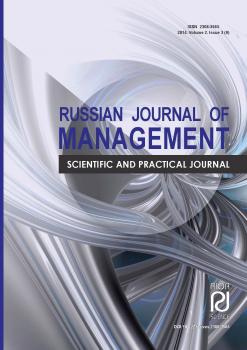The current state of the control mechanism reproduction of the labor force in the Russian North is analyzed. Its compliance with the strategic objectives of development of the northern territories of Russia is determined. The key problems of the existing mechanism of management and direction of its development in the conditions of implementation of strategies for the development of the Russian North and the Arctic are identified.
personnel management, labor, reproduction of labor power, management mechanism, the Russian North, strategy
Развитие Российского Севера и Арктики в современных условиях стало одним из стратегических приоритетов для всей страны. Система концептуальных и программных документов предполагает обеспечение национальных интересов в Арктике, поддержание национальной безопасности и устойчивого социально-экономического развития Российского Севера, повышение качества жизни населения и наращивание человеческого капитала, техническое перевооружение, развитие инфраструктуры, опережающее воспроизводство сырьевой базы, формирование новых нефтегазовых комплексов с развитием адекватной инфраструктуры на северных территориях [10; 14; 15; 18].
В силу суровых климатических условий, малопривлекательных для жизни людей, одной из основных проблем менеджмента на всех уровнях в условиях Севера становится привлечение и воспроизводство рабочей силы, формирование постоянного населения территорий и кадрового ядра предприятий. Более того, учитывая цель обеспечения национальной безопасности и геополитические интересы России на Севере, предполагается отойти от узко-экономического подхода к освоению территории, в соответствии с которым временное привлечение работников дешевле и эффективнее создания условий для постоянного проживания. Поскольку речь идет о контроле над стратегически важными регионами, государство готово вкладывать определенные средства в процессы и институты воспроизводства рабочей силы, предоставляя частному сектору помощь в данном вопросе. Это благоприятствует формированию постоянной рабочей силы и ее полноценному воспроизводству на самом Российском Севере. Разумеется, полный отказ от временного привлечения рабочей силы, в частности, вахтовым методом, в настоящее время также невозможен.
1. Zhiteli Arkhangel´skoy oblasti vystupili za sokhranenie sotsial´nykh l´got [Residents of the Arkhangelsk region were in favor of the preservation of social benefits]. URL: http://dvinaland.com/?p=3842.
2. The meeting of the Security Council on the implementation of the state policy in the Arctic, April 22, 2014. URL: http://kremlin.ru/events/president/news/20845. (in Russian)
3. Information letter of the Department of Pensions of the Ministry of Labour and Social Development of the Russian Federation (June 9, 2003 No 1199-16), Department of incomes and living standards of the Ministry of Labour and Social Development of the Russian Federation (May 19, 2003 No 670-9), the Pension Fund of Russia (June 9, 2003 No 25-23 / 5995). (in Russian)
4. Karpushkina A.V. Institutsional´noe proektirovanie sotsial´nogo partnerstva v sfere truda [The institutional design of the social partnership in labor]. Chelyabinsk, South Ural State University, 2009.
5. Naberezhnaya A.T. Modelirovanie i otsenka urovnya zhizni naseleniya regiona [Modeling and evaluation of living standards in the region]. Yakutsk, Yakut Scientific Center of the Siberian Branch of the Russian Academy of Sciences, 2007.
6. Nuzhno pereosmyslit´ poryadok predostavleniya «severnykh» l´got [We need to reconsider procedure of “northern” benefits]. URL: http://primgazeta.ru/news/marina-semolina-we-need-to-reconsider-the-order-granting-the-north-benefits.
7. Federal Law of February 19, 1993 No 4520-1 “On State Guarantees and Compensations for people working and living in the Far North and equivalent areas”. (in Russian)
8. Decree of Ministry of Labor of the Russian Federation of November 22, 1990 No 2 “On approval of Instruction on the procedure of social guarantees and compensations to the persons working in the Far North and areas equivalent to the Far North”. (in Russian)
9. Government Decree of March 18, 2015 No 249 “On approval of the establishment and payment of fixed payments to the increase of pension to persons residing in the Far North and equivalent areas”. (in Russian)
10. Principles of State Policy of the Russian Federation in the Arctic for the period till 2020 and beyond (approved by the President of the Russian Federation on September 18, 2008 No Pr-1969). (in Russian)
11. Regulations on the Ministry of Regional Development of the Russian Federation (approved by the Government Decree of January 26, 2005 No 40 (repealed)). (in Russian)
12. Prasolov V.I. Problems of development of the institution of tripartism in modern Russia. Vlast´, 2011, no 3, p. 38-40.
13. Roshchina I.V., Dyatlova N.A. Municipalities and social and labor relations: the influence of interdependence. Vestnik Tomskogo gosudarstvennogo universiteta [Bulletin of Tomsk State University], 2013, no 373, p. 158-162.
14. The development strategy of the Arctic zone of the Russian Federation and the national security for the period up to 2020 (approved by the President of the Russian Federation on February 20, 2013). (in Russian)
15. Strategy of socio-economic development of Siberia until 2020 (approved by Decree of the Government of the Russian Federation on July 5, 2010 No1120-p). (in Russian)
16. Labor Code of the Russian Federation of December 30, 2001 No 197-FZ. (in Russian)
17. Fauzer V.V. Theoretical and conceptual approaches to the development of the Russian North. Korporativnoe upravlenie i innovatsionnoe razvitie ekonomiki Severa. Vestnik Nauchno-issledovatel´skogo tsentra korporativnogo prava, upravleniya i venchurnogo investirovaniya Syktyvkarskogo gosudarstvennogo universiteta [Corporate management and innovative development of the economy of the North. Bulletin of the Research Center of corporate management and venture investment of Syktyvkar State University], 2008, issue 4, p. 90-120.
18. Russia´s Energy Strategy until 2030 (approved by Decree of the Government of the Russian Federation on November 13, 2009 No1715-p). (in Russian)














